The powers that be seem to be pushing us toward a day when the Earth has been radically pruned and reorganized to support humans and their domesticated species (animal and vegetable). Nothing else counts. Some would say that this would destroy the very ecology that supports us and our domesticates and would lead to mass extinctions and then an uninhabitable Earth.1 These malcontents assert that we have to care for our current home, because “there is no Planet B.”
Scientific exploration of exoplanets is in its earliest days. Perhaps there is a Planet B out there somewhere. That would surely solve all our problems…wouldn’t it? These five authors have their doubts.
Methuselah’s Children by Robert A. Heinlein (1958)
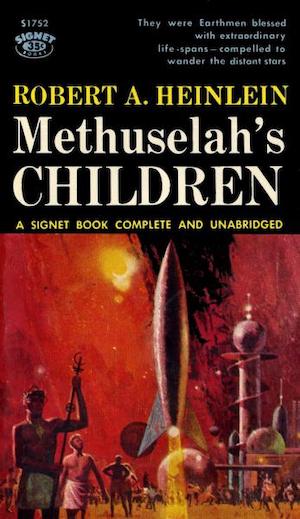
Confident that society had matured enough to accept the presence of a sub-population of age-resistant quasi-immortals, the Howard Families revealed their existence to their short-lived neighbors. Said neighbors wasted little time disappointing the Howards. Surely, there must be a secret to extended life beyond good genes! Surely, the Howard Families can share…and if they won’t, then they must be forced to share.
Realizing too late the extent of their error, the Howard Families, led by Lazarus Long, hijack a convenient sublight starship and flee a hostile Solar System. The good news? Either they are lucky or habitable worlds are common: their very first destination has a habitable world. The bad news? The planet is not just habitable but inhabited—by entities, some of whom are nigh godlike in their powers. Flight seems a logical response…but what waits on the next world is perhaps even more disquieting.
At this point in Heinlein’s career, aliens (even seemingly backward ones like Space Cadet’s Venusians) are always worthy of respect. In this case, the aliens are as gods. Contact with them is disquieting. (Later, Heinlein seems to have changed his mind about aliens [see Starship Troopers].)
“Vaster than Empires and More Slow” by Ursula K. Le Guin (1971, Collected in The Wind’s Twelve Quarters)
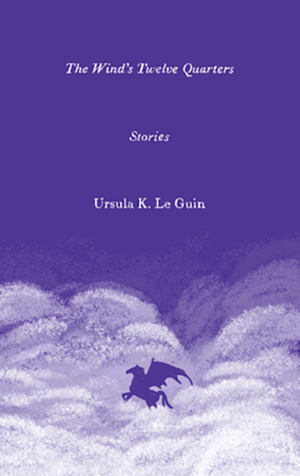
The League of All Worlds abounds with habitable, inhabited worlds, but all were seeded in ages past by the ancient Hain. Whether Earthlike worlds are as common outside the reach of the old Hain is unclear. Thus, the League dispatches a sublight ship to World 4470, well beyond the realm settled a million years ago.
World 4470 is habitable. Unlike the League worlds, it lacks native humanoids. World 4470 appears to lack animal life of any variety. It is a veritable living paradise, whose occupants are of a nature humans cannot easily recognize as possessing minds like theirs. It’s a Garden of Eden whose snake is the shipload of humans contaminating a world they do not understand.
It probably didn’t help the explorers manage this first contact that, until World 4470, the League of All Worlds only had to manage establishing relations between closely related human species. Dealing with entities outside their genus, let alone kingdom, is not in their skillset.2
The Gates of Eden by Brian Stableford (1983)
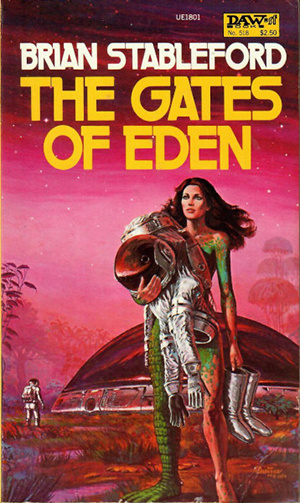
Hyperspace provided access to the universe with a very important catch. There is no known way for a ship to navigate within hyperspace without a hyperspace beacon at the destination. The primary method of planting beacons in extrasolar systems is sublight starship.3 Consequently, exploration of the galaxy has been much more glacial than one might expect, given FTL drives.
After centuries of travel, sublight probe Ariadne reports the third known Earthlike world4, this one without an indigenous technological civilization. Previous experience suggests that Earthlike worlds produce Earthlike species. Previous experience is biased by the fact that the only two known Earthlike worlds have indigenous technological civilizations: evolution had to have proceeded down paths that produced technologically adept humanoid beings. There are other options available, life paths worlds like Earth and Calicos (the second world discovered) should fear.
For some reason, telescope technology always seems to lag in universes with superluminal flight. We’re already cataloging exoplanets but the civilizations in this book have to send physical probes to other systems. Presumably, there’s an inverse function between remote sensing and transportation technology. Build a fast enough starship and determining the nature of alien worlds might require licking them.
The Expert System’s Brother by Adrian Tchaikovsky (2018)
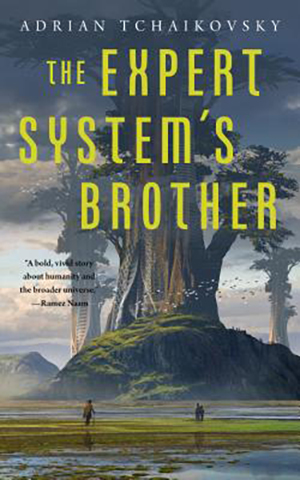
Although no person living in the era in which TESB is set remembers this, whoever settled the planet at the centre of the narrative discovered firsthand the difference between “life-bearing” and “habitable.” The world has its own history, as rich and diverse as Earth. Alas, it does not offer a niche in which humans can live. Unless they are extensively modified.
Thanks to aging Doctor Corto’s carelessness, young Handry is exposed to a substance intended to identify condemned criminals as the shunned. A full dose would have immediately transformed Handry into a doomed outcast. As it is, exile is only deferred. Handry is ultimately cast out. If he is to survive, he must rediscover some facts about his world.
Whoever settled this world seems to have gone well out of their way to find as cruel and inhumane a solution to their situation as possible.
Meru by S. B. Divya (2023)
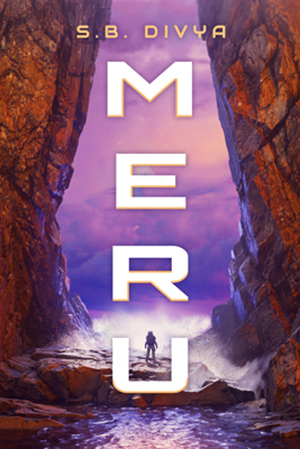
The human track record re: violence and environmental spoilation is dismal; hence the Constructed Democracy of Sol confines humans to Earth. This quarantine would be disappointing if there were other habitable worlds to which humans could travel and perhaps emigrate. But there aren’t. The galaxy abounds with exoplanets, none of them Earthlike. Their environments would kill a naked human.
This is not a problem for humanity’s children, the cyborg Alloys, who are able to adapt to almost any circumstances. No surprise that Alloys outnumber baseline humans. They exist in numbers that allow them to handily outvote humans, which in turn permits the Alloys to confine their older kinfolk to despoiled Earth.
The newly discovered exoplanet Meru is marginally habitable by humans. Should humans be allowed to settle there? Conservatives say no, but more liberal folk push for carefully managed settlement. The question is to be settled by a test. Jayanthi, adopted human child of two Alloys, is sent to Meru. If she can explore and settle without giving into the human predilection for ruining worlds, then perhaps humanity might be allowed to settle there.
Such a development would upend Alloy-human relations. It is not surprising, therefore, that behind the scenes, steps are taken to ensure failure.
In the Alloys’ defense, by the time they stepped in and took over, baseline humans had trashed not just Earth but also Mars, courtesy of an insufficiently well-thought-out terraforming project. That said, the extremes to which Alloys are willing to go to assure predetermined results suggests they are closer to baseline humans than they would like to believe.
***
There is lots of plot potential in Earthlike worlds that prove to be much less habitable than first believed (Brian Stableford in particular returned to that theme over and over). There are many I did not mention. Feel free to list your favourites in comments, which are, as ever, below.
In the words of fanfiction author Musty181, four-time Hugo finalist, prolific book reviewer, and perennial Darwin Award nominee James Davis Nicoll “looks like a default mii with glasses.” His work has appeared in Interzone, Publishers Weekly and Romantic Times as well as on his own websites, James Nicoll Reviews (where he is assisted by editor Karen Lofstrom and web person Adrienne L. Travis) and the 2021 and 2022 Aurora Award finalist Young People Read Old SFF (where he is assisted by web person Adrienne L. Travis). His Patreon can be found here.
[1]A trashed Earth would be uninhabitable by humans and most other modern lifeforms. But it wouldn’t necessarily be lifeless. Earth was an anoxic hell-hole for two billion years and it’s only recently that it has swarmed with oxygen-dependent multicellular life (see: https://eas.gatech.edu/news/did-earths-early-rise-oxygen-support-evolution-multicellular-life-or-suppress-it). However, life appeared long before the latter-day flirtation with habitability as humans define it (https://www.science.org.au/curious/space-time/origins-life-earth).
[2]The League seems to have chosen crew they viewed as mad, on the grounds that no sane person would volunteer for such a lengthy sublight voyage. However, their definition of mad in this case seems a bit circular, since to volunteer at all would be deemed at least a bit peculiar.
[3]The second Earthlike world Earth discovered is Calicos. Calicos was not discovered by sublight probe but because, like Earth, Calicos is home to an advanced technological civilization up to the task of building HSBs. Huzzah for the cause of CETI, but bad news for would-be star colonists of either species, as neither world is unoccupied.
[4]Or as the aliens on Calicos put it, Calicos-like.











I know I’m rolling a saving throw here :-( but KSR’s “Aurora”.
Larry Niven’s Known Space stories go long on this: in the days before FTL, the UN sends probes to nearby Sol-like stars which survey their systems and send back one bit of data: whether or not they found a planet that had so much as a square meter of human-habitable surface. And thus were one-way colony ships dispatched to planets just marginal enough for survival.
I remember a YA novel that had a secret society that gave up on Earth and prepared an ark to colonize elsewhere (Mars?). The ship was supplied with all one needs to survive on an alien world. The YA female protagonist was accidentally brought along as the young sister of one of the members. The leaders were so obnoxious that a mutiny happened. Realizing that they didn’t have the fuel to get to the chosen planet, they returned to Earth, realizing that they had “packed” everything they needed to survive on a broken Earth. I always liked the premise that the energy that you would put into running away you could be putting into fixing the problem.
J. T. McIntosh’s “First Lady” posits (typically for stories written 70 years ago) that men would set up a colony; if it seemed survivable, the final test would be to send one woman to become pregnant there. The punchline isn’t that the chosen one is an immature brat (just the sort of person you’d want in a new colony…), but that the escort couple (assigned to make sure the chosen one doesn’t get pregnant on the way there) know that the odds are high that the pregnancy will turn out badly. I don’t recommend this, or anything else by McIntosh, but ISTM it fits our host’s parameters.
A fan and PhD biologist I knew decades ago had a more subtle approach, brought on by his disbelief in Niven’s claim that Kzinti females were nonsentient (implausible to evolve, because Kzinti males were too bad-tempered to raise kids without killing them). A periodic plague has minimal effect on one sex but reduces mature members of the other to several sigmas below average intelligence. How likely a plague is to infect people from another planet is a separate argument. Unfortunately this never got published beyond a local fanzine, despite encouragement from a neighbor who did become a pro writer.
Bradley chose a psychoactive pollen (aphrodisiac and psi enhancer) to periodically blow over Darkover, letting her cock a snook at the Campbellians who believed that humans would inevitably maintain a technological civilization if cast away on a generally empty planet. Bradley’s home life has altered how some of her writing is now read.
McCaffrey’s Pern may be the penultimate example in SF of a planet with a booby trap: every 200 years, another world gets close enough that its ~inhabitants can ~invade.
The ultimate example might be Asimov’s The Currents of Space, in which the rulers of one world are wealthy because it’s the only place a certain plant will produce a fiber better than silk; all is fine for the rulers until someone shows that the conditions that lead to this fiber are about to make the planet’s sun go nova.
Saying Heinlein seems to have changed his mind about aliens because he had good ones in some novels then bad ones in a later novel is like saying Gene Roddenberry changed his mind about aliens because he started with Vulcans and Talosians then ended up with Klingons, Gorns and Borgs. Some of Heinlein’s better aliens (e.g. The Star Beast, the Martians in Stranger) were written around the same time as Starship Troopers.
Great recommendations here & in the comments.
Adding my fav, Robert Charles Wilson’s Spin, Axis, Vortex trilogy, where the destruction of Earth’s biosphere is chronicled as part of the stories.
& 2nd fav, Vernor Vinge’s Marooned in Realtime, where the earth is still habitable, largely due to the mysterious disappearance of humans, but the story takes place so far in the future with a biosphere wildly changed from our times that it might as well be another planet.
So many great variations on this general theme!
I read Bova’s “Exiles” books in middle school and loved them! Re-read them in my thirties and, well, they have not aged well. Very early 70’s “hard” SF. Pretty much hit all the same points as Methuselah’s Children and Orphans of the Sky so I guess they qualify
Sure, humanity gets a bad rap for being, rapacious, greedy, and generally disagreeable but let us not forget those pugnacious aliens that move in uninvited. Silverberg’s “The Alien Years” comes to mind. Or, “Annihilation” by J. Vandermeer. Then, of course, the grand-daddy of them all, H.G.Wells “War of the Worlds”. Perhaps the best compromise is to follow that time honored advice, “when in Rome, behave as the Roman’s”. Robert Culp did it in “The Architects of Fear” episode of the Outer Limits. Also, if memory serves, I recall a Mars-centric novel that featured a heavily modified human that could live on the surface without need of an environment suit.
7: I thought the best Exile book was the middle one, in which the star travellers have to decide whether to adapt their kids to the not as Earthlike as they hoped world around Alpha Centauri or head to another star in their aging (and retrofitted) generation ship. Unfortunately for the characters, Bova was keen to write his own version of Orphans of the Sky.
9: That last may be Pohl’s Man Plus.
In Cordwainer Smith’s “Instrumentality of Man” timeline, Earth is devastated by the “Ancient Wars” sometime in the late 20th – early 21st century, leading to the collapse of most nations (except China) and humanity surviving in isolated regions. With the discovery of interstellar travel, mass colonization occurs; while Earth eventually becomes more habitable, it apparently never regains significant population. Its primary importance seems to be as the seat of Lords of the Instrumentality, based in the megapolistc “Earthport,” which stands near the site of the ruins of the forgotten city “Meeya Meefla.”
I have to say if I was going to guess what city could still be around thousand of years from now, Miami would not be the city I selected.
If the war happened early enough, sea level rise may have been less of a factor.
I’d kind of expected more stories in which humans left behind a ruined and depopulated Earth, which seems to be becoming de rigeur for interstellar settings. Becky Chambers’ Wayfarers, Whedon’s “Firefly”, enough others that it’s become a regular sore point.
(When I was young I identified with the intrepid survivors. Now I identify with the poor sods who don’t get asked onto the escape ship.)
@3: An Alien Music by Annabel Johnson. I read it in my high school library and tracked it down many years later; it was a vivid read. The earth was suffering a catastrophic climate collapse, and I think it was actually a last-ditch secret government mission to establish a base on Mars.
There was another book I read around the same time, The Missing Person’s League by Frank Bonham, that involves a dystopian collapsing Earth environment, and a secret colonization project.
*chants from the shadows: The Expanse, The Expanse, The Expanse!*
I mean, seriously: in the beginning of the series Earth is in barely tolerable condition, humanity has spread to Mars, belt and outer planets. I feel it portays supremely well the dystopia created by mega corporations and people who work under their thumb, but simultaneously shows the underclass ties and ability to get along, form new societies, new culture, love and care together in harshness of space. How space changes the bodies, how we change bodies for space and planets.
And as the series goes on, well, yeah, someone definitely ruined the Earth even more and now what?
If you extend the “ruined” category to include “ruined for us, the Pilgrims/Puritans, so we’re going to leave all those cootie-ridden Others behind to rot in miserable Otherness,” you could include:
* Grayson in Weber’s Honor Harrington series. The settlers, using telescopic technology, thought they had found a paradise where they could burn their ships and take up a life of agrarian purity according to the teachings of an American Protestant visionary. However, long-distance inspection failed to reveal that all that lovely Earthlike vegetation was loaded with heavy metals. The descendants have, mostly, dealt with it in ways that don’t require an oppressed underclass.
* The first homeworld of the Kolnari in the Brainship series by McCaffrey et al. A bunch of Darwinists from somewhere near the Indian Ocean settle a planet where you get uranium by fishing for it. Over the centuries, the survivors become a subspecies that is composed of super-duper-supermen right up until they begin to die of ruinous old age at 50. When they ruin their homeworld, they turn pirate–or, in their words, they seek to spread the Divine Seed among the stars. (I have toyed with a fic in which they only think that Kolnar has become uninhabitable even for them. The scumvermin they left behind are doing just fine TYVM, but they are careful to hide their presence.)